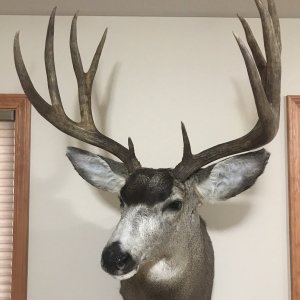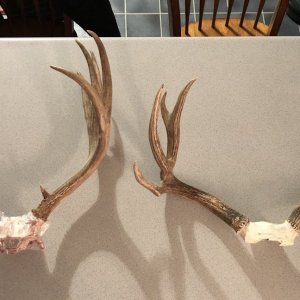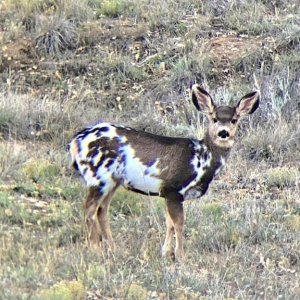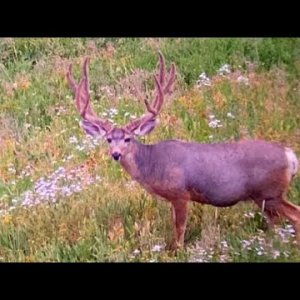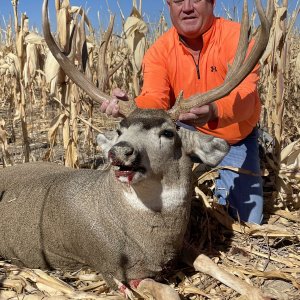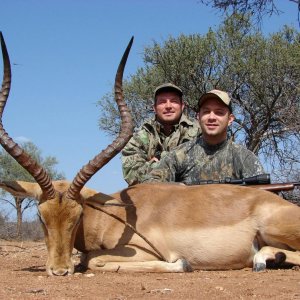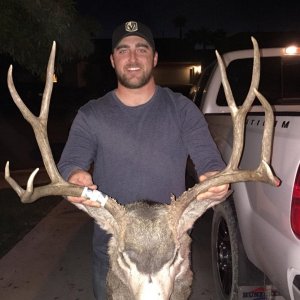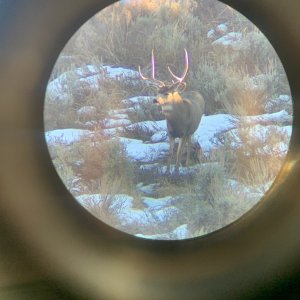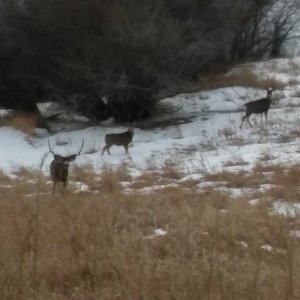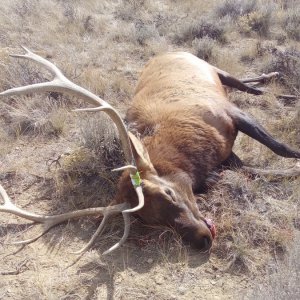wymoosehunter
Active Member
- Messages
- 134
I see lots of questions on MM regarding the various drawings in the western states and how to go about applying, is it worth it, and what kind of strategy would a person take to draw desired tags. Frankly, it comes down to how committed a person is in drawing various tags, what quality of animals they expect to see/harvest, what experience they are expecting, and of course the real kicker: money. I want to share a generic version of my plan to help out those who are in a similar situation: middle income average Joe that loves to hunt different places and species and how best to go about it. If you are wealthy and want to draw great tags year after year, quit reading this post and send a blank check to any of the tag application services and sit back and draw. If you aren't wealthy, hopefully this post will help you compete with those tag application services.
I surely am not an expert in statistics, wildlife biology, nor am I a professional hunter, but I have invested a considerable amount of time and effort in creating an application plan for me and my family. When you break it down to the barest elements of the application season, you need to have a plan. A plan is nothing more than prioritizing what is important to you and what you want in the end, considering the limitations imposed on you, which is most likely money. Remember, the states need money to operate, so most have gone to some type of point (revenue) system that sucks money out of your pocket for absolutely nothing of value. But, to draw tags in point states, you have to play the game to draw a tag. Also, don't place a value on your points when something changes (like Utah) wherein you throw good money after bad. My system has allowed me not only to compete, but beat the high dollar application services when it comes to getting a great tag with fair regularity. Remember, this is a numbers game, so to maximize your odds of drawing a tag, you have to apply in as many different places as possible to increase your odds.
Also, it is impossible to keep everything straight for each of the various states; application deadlines, costs, prerequisite licenses, etc, so create a spread sheet that you can understand and modify year to year to keep track of your plan. My spread sheet includes a section for each state, with each species available, a column for drawing odds for my intended unit(s), submission date(s), results dates, cost per species, and a misc. column so that I can put notes on units or other information as I do my yearly research. Most importantly, create your spread sheet in the order of application deadlines and have a column (or row) to denote that you have applied for a particular species. I also color code my spread sheet so that I can see at a glance whether a deadline is approaching, I have applied for a particular species, and other decisions.
Remember too, that you will get out of it what you put into it, so spend a lot of time doing your research to include: draw odds for particular units (critically important to drawing a tag-There are great trophies in units not lambasted on foolish hunting journals, what units are capable of producing, is it a backpack wilderness hunt and are you capable of that, range of the animals in the unit, where are the animals during the hunting season, etc. Talk to biologists, research the internet (MM has a great drawing odds resource), talk to outfitters at the various conventions and expos, etc. Once you have made a short list of units/species, scout the units if at all possible. Know what you are going to be getting into before you even apply. A family vacation that takes you past the Florida Mountains in New Mexico may make you realize that an Ibex hunt there is too much for you (that is one steep, rugged, beautifully ugly mountain to hunt).
Then once you are ready with a plan, think about your hunting opportunities wherever you live. I have been blessed with growing up in Montana, and having lived in a number of other western states where I literally have good hunting opportunities right out my door. I always plan to have a deer, elk and probably an antelope hunt set up for my home state, and most importantly, I am not disappointed if all I hunt that year is deer, elk and antelope. Being outdoors with my son and wife is really all that matters. If I get a great tag elsewhere, bonus!
It is impossible to postulate what is most important for everyone, so I will outline what is important for my family and how I go about applying to cover those bases.
My son is not yet 12, so that limits where I can apply for him. I have a sneaking suspicision that he will be a hardcore hunter, so I apply him for points in those states that have them and allow youngsters to amass points. I will not put him in for once in a lifetime type tags until he is mature enough to understand that having one of those tags is a major commitment in of itself, and for now we concentrate on fun, easy hunts. Of course this strategy will change as he gets older. For now, we will be hunting deer, elk, antelope and turkey where he will see lots of critters and have opportunities. But he will be building points for OIL species in our home state and elsewhere.
My wife likes to hunt and likes to go to ?exotic? locations, but is not really a hardcore hunter. She is perfectly happy going on a family elk/deer/antelope hunt. So we will not be putting in for a ?hang from your fingertips? mountain goat hunt that requires a two day backpack trip just to get there. She would not enjoy straddling a rock spine ridge with a fall of a 1000 feet on either side if you mess up. So we know her limitations. We look for fun, relatively easy hunts that have an exotic flair. She has taken a couple of deer, antelope, a moose and an oryx, none of which I would classify as hardcore hunts, just fun family adventures. She does want a mountain goat and a sheep, so I apply her in some states/units that offer a good hunt that is not too crazy for her desires/likes. Someday she will be hunting those species. She still thinks that elk are mythical creatures, but she will get a good bull someday.
Me, I am a hardcore hunter, I like exotic locations, I love mountain hunting in the truest sense of the word, so I concentrate on way different hunts than my spouse and son. I live for sheep and goat hunting, with a secondary interest in big mule deer, big elk and some ?exotic? species. I want to do everything as a DIY hunt if at all possible, and only hunt fair chase free ranging animals. I am willing to backpack for two or three days to get to an area, spend two weeks hunting and another week getting my animal and me back out of the woods. Unfortunately, that will change as I age, but I will fight that by staying in good shape.
I apply for sheep in every state except for California and Washington. They just don't have a return on my application dollars. Utah is close to being axed as the recent changes by the game and fish department has all but made Utah impossible to draw for any quality animal/unit. Frankly, I will be a very old man before I ever draw there, if ever, if they keep the current draw structure. If you apply in a prerequisite license state, you might as well build points/apply for all the animals that interest you, you spent the money already. I apply in the following states in the following order given my hunting desires and I consider the following states mandatory apply for states:
1. Montana-cheap license/application (for OIL animals) and decent odds, especially if you don't demand a breaks sheep tag. Great moose and goat too. Strange application system for draw deer and elk units, but that is changing. Once that is changed, I will apply for deer and elk there. I really believe that I will draw a sheep and goat tag here before I am too old to hunt.
2. Idaho-best drawing state with a straight up luck of the draw system. You can only apply for one species in Idaho, which makes for good draw odds. Pick your favorite species and apply, you can't go wrong, but you do have to buy a license to apply. If you really want to goat or moose hunt, if you apply for a reasonable period of time (and unit), you will draw in Idaho. I really believe that I will draw a sheep tag here someday. Decent state to buy a OTC deer or elk tag if you don't have any luck in the various draws.
3. New Mexico-very expensive sheep tag, but I like straight up luck of the draw systems. Plus very good elk hunting with rather good drawing odds. You can apply for exotics like oryx, Barbary, Coues and ibex. One of my favorite states to apply for.
4. Wyoming-expensive to play the points game as an NR, but good odds of drawing for a dedicated applier. All species are in play. You will hunt deer, elk, and antelope every 2-3 years and will probably draw a OIL animal at some point. Buy a leftover tag and you can hunt WY every year.
5. Colorado-If you apply long enough, you will draw outstanding deer and elk units. You can hunt a quality unit every 3-5 years in Colorado by avoiding the recommendations in those foolish hunting journals. Sheep, goat and moose: you have to play the points game, but it is worth the effort. You will probably draw one or more in your hunting lifetime. Best state to buy an OTC elk tag if you don't get any love in the drawings.
6. Nevada-I hate point states, but Nevada has arguably the best point system. Apply for your favorite species and you will probably end up hunting there someday. Great elk and deer trophy potential. Nevada gives out the most desert sheep tags of any state and with some luck, you may draw there in your lifetime.
I consider the following states discretionary states to apply for. If you have the money and inclination to spend time doing the research, you may want to consider applying in these states. Just bear in mind, you probably will never draw a good tag, or any tag for that matter in these states and they are very expensive to apply in.
7. Oregon-Sheep only would be in the mandatory application section. Straight up draw and reasonable tag price. Downside is that you have to buy a license just to apply. The rest of the draw animals are just not worth it and they are all point systems with very little chance of drawing in the foreseeable future. Oregon has to get its act together on deer, elk, antelope. The coastal elk and deer are good, but they are OTC. I got lucky and drew a sheep tag here-proof that straight up draws, good research, and applying everywhere you can results in making your own luck.
8. Arizona-I hate their point system but I still apply as I really want a desert bighorn. Since I am wasting my money buying a NR license just to apply, I build deer and elk points. I will get to hunt deer and elk here at some point. Great trophy state, just a messed up point draw system. If money gets tight, I am dropping this state before any of the above.
9. Utah- I still apply just because I have so many desert sheep points, but this is the first state to go if money gets tight. You have to buy a license just to apply. Great elk and deer in select units, but the odds are you will never draw in this state in a decent area. Odds are that because of the greedy points system Utah just changed to for NR?s only, you will never draw a sheep, goat, moose, buffalo tag here period. It used to be you had to pick a species and apply only for it, there never was really good odds, but at least it appeared that you could possibly draw one species in a lifetime. Not now. Utah hates everything about NR?s except their money. Save your money if you are just getting into the points game and really evaluate continuing unless you have 15 or more points already in this state.
10. Washington-I would apply there for moose if I really wanted one. However, I just can't justify the application expenses for sheep as the odds are so bad that the raffle tag offers better odds for far less money. Buy a couple of raffle tags for sheep.
11. California-Forget about it. Total waste of money. No chance of drawing a sheep or tule elk tag. All the other opportunities are mediocre at best.
Remember, you can't draw if you don't play, but be smart about it. I have never added it up (because I know I would be frightened of the number), but I guess that I spend about $1500 a year on applications, not including the tag(s) we draw. This is my number one form of entertainment, so it is worth it to me, but everyone is different. You will have a substantial amount of money (thousands or even tens of thousands of dollars) sitting out there for tag fees, but you will get most of it back after the drawings.
Consider raffles. Washington has a raffle tag for sheep that is so inexpensive, that anyone can buy at least one ticket. Buy three or more tags and you have better odds than the draw system for sheep. I will never be able to afford a Stone sheep hunt, so I do research on raffle tags and I buy a couple every year. Being an eternal optimist, I believe that I will go Stone hunting someday. Winning a Stone sheep hunt on the raffles that I have been buying is better odds than any of the sheep tags I have drawn in the state draw systems.
Also, don't think that just because you are so far back in the points game that you or your kid(s)/ grandkid(s) will never be able to draw. Apply and apply in every state you can afford. I really believe that the backlash is coming wherein states will have to do something about the current points systems. All you have to do is look at Oregon, Utah, Colorado and Arizona. Colorado is very aware of the problems of their point system, especially as it pertains to deer and elk, and they have started to slowly address it. Not very well I might add, but the first step is realizing there is a problem and start fixing it. Oregon as a state is so broke that the game and fish have to be greedy just to have some semblance of a viable department, all at the detriment of the wildlife. Utah game and fish administrators are just greedy and stupid. (I am not dinging the hardworking employees of these departments, just their administrators/boards of directors).
Lastly, all my non-serious hunting buddies are always questioning me about what happens if I draw multiple tags in a season. I tell them that it is a great problem to have. I have had that dilemma and it was a great dilemma to have. It took a lot of planning, but I managed to hunt a sheep and two moose in one year. It was awesome. I wish I could have split the moose hunts up over different years, but? Just be prepared to eat a lesser tag if you have to. I apply for premier deer, elk, and antelope tags in my home state, but if I don't draw a quality tag, I don't buy a general tag until all of the special draws are done in all the states. That way, if I do draw a tag that I will focus all my vacation time and money on, I can do so without regretting having a general tag that will go unused.
I know this is long, but hopefully some will find it useful. It is very generalized and I know that, but I am not willing to post my spreadsheet and drawing matrix for everyone to see. It took me years to create and research and every year I spend at least a hundred hours doing additional research. I have done the math and statistically, I will draw a quality tag about every year, and about every three years I will draw a OIL type tag. My results bear that out as well as I have drawn six OIL type tags in the last seven years. Don?t be discouraged as it does take a few years to get into the running for most tags. Then it is a matter of persistence.
Good Luck in all the draws.
WyMo
I surely am not an expert in statistics, wildlife biology, nor am I a professional hunter, but I have invested a considerable amount of time and effort in creating an application plan for me and my family. When you break it down to the barest elements of the application season, you need to have a plan. A plan is nothing more than prioritizing what is important to you and what you want in the end, considering the limitations imposed on you, which is most likely money. Remember, the states need money to operate, so most have gone to some type of point (revenue) system that sucks money out of your pocket for absolutely nothing of value. But, to draw tags in point states, you have to play the game to draw a tag. Also, don't place a value on your points when something changes (like Utah) wherein you throw good money after bad. My system has allowed me not only to compete, but beat the high dollar application services when it comes to getting a great tag with fair regularity. Remember, this is a numbers game, so to maximize your odds of drawing a tag, you have to apply in as many different places as possible to increase your odds.
Also, it is impossible to keep everything straight for each of the various states; application deadlines, costs, prerequisite licenses, etc, so create a spread sheet that you can understand and modify year to year to keep track of your plan. My spread sheet includes a section for each state, with each species available, a column for drawing odds for my intended unit(s), submission date(s), results dates, cost per species, and a misc. column so that I can put notes on units or other information as I do my yearly research. Most importantly, create your spread sheet in the order of application deadlines and have a column (or row) to denote that you have applied for a particular species. I also color code my spread sheet so that I can see at a glance whether a deadline is approaching, I have applied for a particular species, and other decisions.
Remember too, that you will get out of it what you put into it, so spend a lot of time doing your research to include: draw odds for particular units (critically important to drawing a tag-There are great trophies in units not lambasted on foolish hunting journals, what units are capable of producing, is it a backpack wilderness hunt and are you capable of that, range of the animals in the unit, where are the animals during the hunting season, etc. Talk to biologists, research the internet (MM has a great drawing odds resource), talk to outfitters at the various conventions and expos, etc. Once you have made a short list of units/species, scout the units if at all possible. Know what you are going to be getting into before you even apply. A family vacation that takes you past the Florida Mountains in New Mexico may make you realize that an Ibex hunt there is too much for you (that is one steep, rugged, beautifully ugly mountain to hunt).
Then once you are ready with a plan, think about your hunting opportunities wherever you live. I have been blessed with growing up in Montana, and having lived in a number of other western states where I literally have good hunting opportunities right out my door. I always plan to have a deer, elk and probably an antelope hunt set up for my home state, and most importantly, I am not disappointed if all I hunt that year is deer, elk and antelope. Being outdoors with my son and wife is really all that matters. If I get a great tag elsewhere, bonus!
It is impossible to postulate what is most important for everyone, so I will outline what is important for my family and how I go about applying to cover those bases.
My son is not yet 12, so that limits where I can apply for him. I have a sneaking suspicision that he will be a hardcore hunter, so I apply him for points in those states that have them and allow youngsters to amass points. I will not put him in for once in a lifetime type tags until he is mature enough to understand that having one of those tags is a major commitment in of itself, and for now we concentrate on fun, easy hunts. Of course this strategy will change as he gets older. For now, we will be hunting deer, elk, antelope and turkey where he will see lots of critters and have opportunities. But he will be building points for OIL species in our home state and elsewhere.
My wife likes to hunt and likes to go to ?exotic? locations, but is not really a hardcore hunter. She is perfectly happy going on a family elk/deer/antelope hunt. So we will not be putting in for a ?hang from your fingertips? mountain goat hunt that requires a two day backpack trip just to get there. She would not enjoy straddling a rock spine ridge with a fall of a 1000 feet on either side if you mess up. So we know her limitations. We look for fun, relatively easy hunts that have an exotic flair. She has taken a couple of deer, antelope, a moose and an oryx, none of which I would classify as hardcore hunts, just fun family adventures. She does want a mountain goat and a sheep, so I apply her in some states/units that offer a good hunt that is not too crazy for her desires/likes. Someday she will be hunting those species. She still thinks that elk are mythical creatures, but she will get a good bull someday.
Me, I am a hardcore hunter, I like exotic locations, I love mountain hunting in the truest sense of the word, so I concentrate on way different hunts than my spouse and son. I live for sheep and goat hunting, with a secondary interest in big mule deer, big elk and some ?exotic? species. I want to do everything as a DIY hunt if at all possible, and only hunt fair chase free ranging animals. I am willing to backpack for two or three days to get to an area, spend two weeks hunting and another week getting my animal and me back out of the woods. Unfortunately, that will change as I age, but I will fight that by staying in good shape.
I apply for sheep in every state except for California and Washington. They just don't have a return on my application dollars. Utah is close to being axed as the recent changes by the game and fish department has all but made Utah impossible to draw for any quality animal/unit. Frankly, I will be a very old man before I ever draw there, if ever, if they keep the current draw structure. If you apply in a prerequisite license state, you might as well build points/apply for all the animals that interest you, you spent the money already. I apply in the following states in the following order given my hunting desires and I consider the following states mandatory apply for states:
1. Montana-cheap license/application (for OIL animals) and decent odds, especially if you don't demand a breaks sheep tag. Great moose and goat too. Strange application system for draw deer and elk units, but that is changing. Once that is changed, I will apply for deer and elk there. I really believe that I will draw a sheep and goat tag here before I am too old to hunt.
2. Idaho-best drawing state with a straight up luck of the draw system. You can only apply for one species in Idaho, which makes for good draw odds. Pick your favorite species and apply, you can't go wrong, but you do have to buy a license to apply. If you really want to goat or moose hunt, if you apply for a reasonable period of time (and unit), you will draw in Idaho. I really believe that I will draw a sheep tag here someday. Decent state to buy a OTC deer or elk tag if you don't have any luck in the various draws.
3. New Mexico-very expensive sheep tag, but I like straight up luck of the draw systems. Plus very good elk hunting with rather good drawing odds. You can apply for exotics like oryx, Barbary, Coues and ibex. One of my favorite states to apply for.
4. Wyoming-expensive to play the points game as an NR, but good odds of drawing for a dedicated applier. All species are in play. You will hunt deer, elk, and antelope every 2-3 years and will probably draw a OIL animal at some point. Buy a leftover tag and you can hunt WY every year.
5. Colorado-If you apply long enough, you will draw outstanding deer and elk units. You can hunt a quality unit every 3-5 years in Colorado by avoiding the recommendations in those foolish hunting journals. Sheep, goat and moose: you have to play the points game, but it is worth the effort. You will probably draw one or more in your hunting lifetime. Best state to buy an OTC elk tag if you don't get any love in the drawings.
6. Nevada-I hate point states, but Nevada has arguably the best point system. Apply for your favorite species and you will probably end up hunting there someday. Great elk and deer trophy potential. Nevada gives out the most desert sheep tags of any state and with some luck, you may draw there in your lifetime.
I consider the following states discretionary states to apply for. If you have the money and inclination to spend time doing the research, you may want to consider applying in these states. Just bear in mind, you probably will never draw a good tag, or any tag for that matter in these states and they are very expensive to apply in.
7. Oregon-Sheep only would be in the mandatory application section. Straight up draw and reasonable tag price. Downside is that you have to buy a license just to apply. The rest of the draw animals are just not worth it and they are all point systems with very little chance of drawing in the foreseeable future. Oregon has to get its act together on deer, elk, antelope. The coastal elk and deer are good, but they are OTC. I got lucky and drew a sheep tag here-proof that straight up draws, good research, and applying everywhere you can results in making your own luck.
8. Arizona-I hate their point system but I still apply as I really want a desert bighorn. Since I am wasting my money buying a NR license just to apply, I build deer and elk points. I will get to hunt deer and elk here at some point. Great trophy state, just a messed up point draw system. If money gets tight, I am dropping this state before any of the above.
9. Utah- I still apply just because I have so many desert sheep points, but this is the first state to go if money gets tight. You have to buy a license just to apply. Great elk and deer in select units, but the odds are you will never draw in this state in a decent area. Odds are that because of the greedy points system Utah just changed to for NR?s only, you will never draw a sheep, goat, moose, buffalo tag here period. It used to be you had to pick a species and apply only for it, there never was really good odds, but at least it appeared that you could possibly draw one species in a lifetime. Not now. Utah hates everything about NR?s except their money. Save your money if you are just getting into the points game and really evaluate continuing unless you have 15 or more points already in this state.
10. Washington-I would apply there for moose if I really wanted one. However, I just can't justify the application expenses for sheep as the odds are so bad that the raffle tag offers better odds for far less money. Buy a couple of raffle tags for sheep.
11. California-Forget about it. Total waste of money. No chance of drawing a sheep or tule elk tag. All the other opportunities are mediocre at best.
Remember, you can't draw if you don't play, but be smart about it. I have never added it up (because I know I would be frightened of the number), but I guess that I spend about $1500 a year on applications, not including the tag(s) we draw. This is my number one form of entertainment, so it is worth it to me, but everyone is different. You will have a substantial amount of money (thousands or even tens of thousands of dollars) sitting out there for tag fees, but you will get most of it back after the drawings.
Consider raffles. Washington has a raffle tag for sheep that is so inexpensive, that anyone can buy at least one ticket. Buy three or more tags and you have better odds than the draw system for sheep. I will never be able to afford a Stone sheep hunt, so I do research on raffle tags and I buy a couple every year. Being an eternal optimist, I believe that I will go Stone hunting someday. Winning a Stone sheep hunt on the raffles that I have been buying is better odds than any of the sheep tags I have drawn in the state draw systems.
Also, don't think that just because you are so far back in the points game that you or your kid(s)/ grandkid(s) will never be able to draw. Apply and apply in every state you can afford. I really believe that the backlash is coming wherein states will have to do something about the current points systems. All you have to do is look at Oregon, Utah, Colorado and Arizona. Colorado is very aware of the problems of their point system, especially as it pertains to deer and elk, and they have started to slowly address it. Not very well I might add, but the first step is realizing there is a problem and start fixing it. Oregon as a state is so broke that the game and fish have to be greedy just to have some semblance of a viable department, all at the detriment of the wildlife. Utah game and fish administrators are just greedy and stupid. (I am not dinging the hardworking employees of these departments, just their administrators/boards of directors).
Lastly, all my non-serious hunting buddies are always questioning me about what happens if I draw multiple tags in a season. I tell them that it is a great problem to have. I have had that dilemma and it was a great dilemma to have. It took a lot of planning, but I managed to hunt a sheep and two moose in one year. It was awesome. I wish I could have split the moose hunts up over different years, but? Just be prepared to eat a lesser tag if you have to. I apply for premier deer, elk, and antelope tags in my home state, but if I don't draw a quality tag, I don't buy a general tag until all of the special draws are done in all the states. That way, if I do draw a tag that I will focus all my vacation time and money on, I can do so without regretting having a general tag that will go unused.
I know this is long, but hopefully some will find it useful. It is very generalized and I know that, but I am not willing to post my spreadsheet and drawing matrix for everyone to see. It took me years to create and research and every year I spend at least a hundred hours doing additional research. I have done the math and statistically, I will draw a quality tag about every year, and about every three years I will draw a OIL type tag. My results bear that out as well as I have drawn six OIL type tags in the last seven years. Don?t be discouraged as it does take a few years to get into the running for most tags. Then it is a matter of persistence.
Good Luck in all the draws.
WyMo

